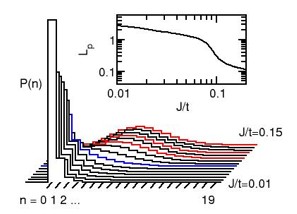Polarons in strongly correlated systems
In system with strong electron-phonon interaction, the carriers loose mobility, ultimately acquiring polaronic character. A polaron is a state in which the phonon and electron degrees of freedom are strongly entangled, and the presence of an electron is associated to a finite lattice distortion, which in turn bind

Phonon distribution function P(n) and magnetic polaron size Lp as function of the exchange coupling J, signalizing the formation of the spin/lattice polaron
s the electron leading to the so-called self-trapping effect. Polarons also tend to create bound pairs, (called bipolarons). Of course the presence of Coulomb repulsion destabilizes bipolarons in favor of a pure polaronic state at finite densities. Coulomb interaction (even screened in the form of Hubbard on-site repulsion) has been found to give interesting interplay with the attractive el-ph interaction in the regime in which the repulsion is so strong to produce strong antiferromagnetic correlations.In this case the increase of the exchange coupling J gives rise to polaron formation reflected in. fig. 1 in the shrinking of the magnetic polaron size as well as in a sudden change in the local phonon distribution associated to the carrier site.
This regime is also likely to describe the low doping phase of the high temperatures superconductor cuprates. In this case these correlations are found to strengthen the polaronic effects. This can explain the behaviour as function of doping and temperature of the MIR absorbtion peak in the optical conductivity.
The key role of antiferromagnetic correlations has been studied quantitatively using Dynamical Mean-Field Theory for the Hubbard-Holstein model, in which a local electron-phonon coupling and the on-site Hubbard repulsion compete. It has been shown that the antiferromagnetic correlations are indeed crucial to give rise to sizeable polaronic (or more generically phononic) effects in correlated systems.
Indeed in the absence of magnetism and short-range magnetic correlations strong correlations strongly reduce phononic effects, at least in the Holstein-Hubbard model, in which both interactions are local. Such a reduction can actually be described in terms of an effective Hubbard model for the quasiparticles, while the high-energy part of the correlated spectrum (Hubbard bands) shows clear phononic fingerprints. This dichotomy can explain the anomalous signature of electron-phonon interaction in the cuprates.
When antiferromagnetism is considered, phononic effects are strongly revived, and they show up both in the electronic and the phonic properties.
The competition between Coulomb repulsion and phonon-mediated attraction gives rise to a rich phase diagram, in which different metal-insulator transition take place as a function of the different couplings for the half-filled system. Isotope effects on different observables have been shown to be particulary sensitive to the boundaries separating the different phases.
People: M. Capone E. Cappelluti S. Ciuchi
References:


